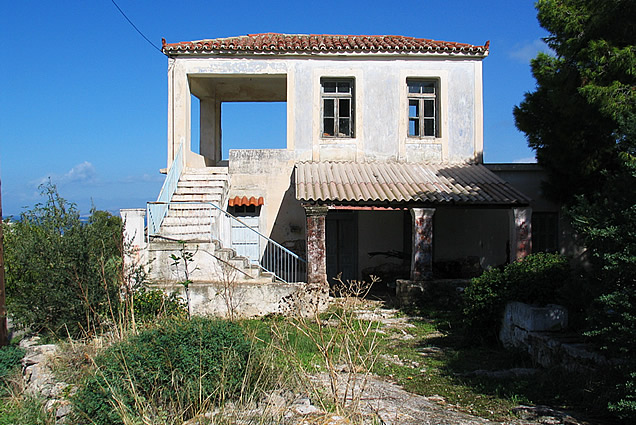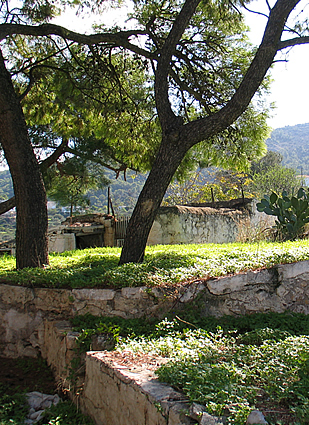home > culture & religion > An Aegina village home in the 19th century
An Aegina village home
In the 19th century
In conversation with Mrs Lina Bogri Petritou, well-known for her talks and writing on the subject of life in Aegina in times gone by. She tells us some of her memories of her grandfather's stories of life in 19th century Aegina.
What would the house of a well-to-do farmer in Aegina have been like in the 19th century?
Firstly our Aegina farmer's house would have land to cultivate, providing enough financial ease that his wife wouldn't have to work alongside him in the fields. The house would consist of two storeys, with a long ground floor and a tall tower-like second floor at one end.
Such a house would have a large garden in front; this would be paved and would definitely comprise a climbing grapevine on a trellis for shade, and flowers such as marjoram, honeysuckle, basil, jasmine, geraniums, roses, carnations and night-scented flowers.
So, let's have a look round. There are olive trees, fig trees, vines and almond trees in the garden. As we approach the house from the garden path we see a table spread with a clean white cloth and a fruit bowl full of seasonal fruit to welcome family and friends. Walking towards the back of the house on the right side, we duck to avoid a canvas bag hanging on a tree full of ripening goats' milk, in the process of becoming 'geremeze' cheese – an Aegina speciality.
At the back of the house is where all the work is done, and a lot of this inevitably takes place in the bakery which is in a separate outhouse from the rest of the building. As we enter the bakery we can see the oven, the kindling piled in the corner, a long shovel and a large tool covered with wet cloths to clean the inside of the oven, all leaning against the wall. On the other side there is a large box full of flour sacks – both wheat and barley – and long wooden bread tins where the dough is left to rise. A rake-like implement is used to clear the ashes out of the oven once the inside of the oven shows white heat, and the ashes are raked out into a little trough at the lip of the oven. Into this trough go potatoes and onions – to be baked whole and eaten with lemon, oil, and 'alakothymaro' mixture of salt and thyme. There is also a large wooden bowl to mix the dough, called a 'skafidi' which was often made from a whole piece of tree trunk. The 'zoumarologos' is a pottery bowl that contains live yeast, replenished after every baking. It is said that on the day of the cross – 14th September – a piece of blessed basil placed on the yeast will make it rise.
Hung around the walls are various different types of sieves, some with a fine grain and some with a coarser grain for threshing the different cereals. There are also stamps used to imprint on the bread for 'prosfora' – the bread that is made specially on holy days. The yeast would also be used to make 'tiropsoma' with oil and crumbled feta and a fried bread delicacy with 'petimeze' (made from the must left over from wine making – very much reduced and very good for sore throats).
On the further side of the bakery there is a large tripod with a massive cauldron in place, with sticks and kindling underneath. This is where the massive weekly wash is done.
First the water must be 'fortified'. Clean wood ashes are strained through linen cloths and a basket balanced over the cauldron. Boiling water is occasionally poured onto the ashes. These drip into the water – and this 'alisiva' is eventually used for the wash. Home made soap is used – a mixture of potash and olive oil boiled up in the same cauldron once a year and poured into a wooden box lined with greaseproof paper and then cut into shapes before setting. Green household soap comes from the kernel of the olive while paradoxically the white soap used for washing hands and face comes from lesser quality oil.
During the washing of dark clothes a last rinse of vinegar or boiled rosemary ensures the colour doesn't fade. A little blue bag is used when washing whites, as well as crushed eggshells.
Wool is dyed here for weaving. The madder plant gives a red colour, onion skins give beige and the soft green skin of walnuts are used for a brown dye for clothes and hair.
There is also a small cauldron for other cooking, usually copper. This is used for jams, marmalades, etc. As well as the bakery outhouse there is a cellar store room for onions, garlic, sun-dried figs, sage, cheeses, oregano, pottery jars full of olives, pomegranates hanging in nets from the ceiling, ewers full of oil and other supplies. Aegina had a good water supply at that time – enough for the cultivation of cotton at Vamvatsea near Vagia. Flax is also grown and the hemp used to make clothes.
At the end of the garden, away from the house is a large poultry house for turkeys and chickens. Also near the chicken house is the dovecot, every house cultivates pigeons for the table - and the stable. The stable houses the donkey – used for transport, carrying small loads etc; a mule or pony for the trap and the treadmill to bring water up from the well in the fields. There is another small well in the front garden near the house, for household use. The goat is out to graze in the daytime, but has her own stall in the stable at night.
By Louisa O'Brien
In conversation with Mrs Lina Bogri Petritou, well-known for her talks and writing on the subject of life in Aegina in times gone by. She tells us some of her memories of her grandfather's stories of life in 19th century Aegina.
What would the house of a well-to-do farmer in Aegina have been like in the 19th century?
Firstly our Aegina farmer's house would have land to cultivate, providing enough financial ease that his wife wouldn't have to work alongside him in the fields. The house would consist of two storeys, with a long ground floor and a tall tower-like second floor at one end.
Such a house would have a large garden in front; this would be paved and would definitely comprise a climbing grapevine on a trellis for shade, and flowers such as marjoram, honeysuckle, basil, jasmine, geraniums, roses, carnations and night-scented flowers.
So, let's have a look round. There are olive trees, fig trees, vines and almond trees in the garden. As we approach the house from the garden path we see a table spread with a clean white cloth and a fruit bowl full of seasonal fruit to welcome family and friends. Walking towards the back of the house on the right side, we duck to avoid a canvas bag hanging on a tree full of ripening goats' milk, in the process of becoming 'geremeze' cheese – an Aegina speciality.
At the back of the house is where all the work is done, and a lot of this inevitably takes place in the bakery which is in a separate outhouse from the rest of the building. As we enter the bakery we can see the oven, the kindling piled in the corner, a long shovel and a large tool covered with wet cloths to clean the inside of the oven, all leaning against the wall. On the other side there is a large box full of flour sacks – both wheat and barley – and long wooden bread tins where the dough is left to rise. A rake-like implement is used to clear the ashes out of the oven once the inside of the oven shows white heat, and the ashes are raked out into a little trough at the lip of the oven. Into this trough go potatoes and onions – to be baked whole and eaten with lemon, oil, and 'alakothymaro' mixture of salt and thyme. There is also a large wooden bowl to mix the dough, called a 'skafidi' which was often made from a whole piece of tree trunk. The 'zoumarologos' is a pottery bowl that contains live yeast, replenished after every baking. It is said that on the day of the cross – 14th September – a piece of blessed basil placed on the yeast will make it rise.
Hung around the walls are various different types of sieves, some with a fine grain and some with a coarser grain for threshing the different cereals. There are also stamps used to imprint on the bread for 'prosfora' – the bread that is made specially on holy days. The yeast would also be used to make 'tiropsoma' with oil and crumbled feta and a fried bread delicacy with 'petimeze' (made from the must left over from wine making – very much reduced and very good for sore throats).
On the further side of the bakery there is a large tripod with a massive cauldron in place, with sticks and kindling underneath. This is where the massive weekly wash is done.
First the water must be 'fortified'. Clean wood ashes are strained through linen cloths and a basket balanced over the cauldron. Boiling water is occasionally poured onto the ashes. These drip into the water – and this 'alisiva' is eventually used for the wash. Home made soap is used – a mixture of potash and olive oil boiled up in the same cauldron once a year and poured into a wooden box lined with greaseproof paper and then cut into shapes before setting. Green household soap comes from the kernel of the olive while paradoxically the white soap used for washing hands and face comes from lesser quality oil.
During the washing of dark clothes a last rinse of vinegar or boiled rosemary ensures the colour doesn't fade. A little blue bag is used when washing whites, as well as crushed eggshells.
Wool is dyed here for weaving. The madder plant gives a red colour, onion skins give beige and the soft green skin of walnuts are used for a brown dye for clothes and hair.
There is also a small cauldron for other cooking, usually copper. This is used for jams, marmalades, etc. As well as the bakery outhouse there is a cellar store room for onions, garlic, sun-dried figs, sage, cheeses, oregano, pottery jars full of olives, pomegranates hanging in nets from the ceiling, ewers full of oil and other supplies. Aegina had a good water supply at that time – enough for the cultivation of cotton at Vamvatsea near Vagia. Flax is also grown and the hemp used to make clothes.
At the end of the garden, away from the house is a large poultry house for turkeys and chickens. Also near the chicken house is the dovecot, every house cultivates pigeons for the table - and the stable. The stable houses the donkey – used for transport, carrying small loads etc; a mule or pony for the trap and the treadmill to bring water up from the well in the fields. There is another small well in the front garden near the house, for household use. The goat is out to graze in the daytime, but has her own stall in the stable at night.
By Louisa O'Brien
| Advertisements: | ||



